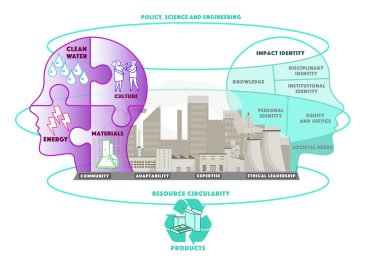CEGE researchers deal with big issues
Six recent projects characterize the reach and import of CEGE faculty research. From circularity ($3 mil) to water distribution systems ($2.1 mil), from mineralized carbon storage ($10.95 mil) to PFAS ($560K), from snowfall ($2.9 mil) to Zebra mussels ($500K), CEGE is facing grand challenges and ensuring human health and welfare.

Circularity — Paige Novak, $3 mil NSF
The Circularity Impact Program (CIP): An NSF Research Traineeship at the University of Minnesota is a unique training program for graduate students. Funded by the National Science Foundation and led by Paige Novak with collaborators across the University, the CIP trains graduate students in the circular use of water, energy, and materials and integrates the study of policy, engineering, and science. A unique aspect of the program is the involvement of an artist in residence to explore different ways of knowing and alternative perspectives on circularity problems. This training will lead to new technologies, policy and economic instruments, methods, and implementation strategies for the circular use of resources.
Water supply — Raymond Hozalski, $2.1mil EPA
The U.S. Environmental Protection Agency is investing $2.1 million in an innovative project to study microbial and chemical contaminants in water distribution systems. Pathogens and disinfection byproducts are two classes of contaminants that are of concern in public water systems. Hozalski and his collaborators will examine opportunistic pathogens and contaminants that occur as byproducts of disinfection processes introduced to control these pathogens.

Carbon Storage — Emmannuel Detournay, $10.95 mil USDOE
The University of Minnesota Twin Cities is the lead institution on a project that received $10.95 million over four years from the U.S. Department of Energy to host a new Energy Frontier Research Center (EFRC) on Geo-processes in Mineral Carbon Storage (GMCS). The center brings together engineers and scientists from five internationally renowned organizations to study a promising technology for permanent solid storage of carbon dioxide (CO2) in geologic formations.
PFAS — Bill Arnold, $560K
Poly- and perfluorinated substances (PFAS) are under intense scrutiny by regulators and the public due to their persistence and toxicity. Fluorine incorporation into organic chemicals is, however, much more ubiquitous than is generally known by the public. Yet, we understand little about the fluorinated byproducts produced upon degradation of fluorinated pesticides and pharmaceuticals. This project quantifies fluorinated byproducts of common compounds assisting in the optimization of water treatment methods and the development of pharmaceutical and pesticide structures to reduce the formation of persistent byproducts.
Snowfall — Ardeshir Ebtehaj, $2.9 mil NASA
NASA awarded Ardeshir Ebtehaj and co-PIs $2.9 million to provide the longest and the most accurate satellite record of global snowfall. Earth’s snowpack is shrinking, glaciers are losing mass, sea ice is declining, and Greenland is melting at an unprecedented rate. These global losses of ice and snowpack are exacerbated as more precipitation is likely to fall in the form of rain rather than snow. These changes in the cryosphere, the frozen portions of Earth’s system, could have important impacts on future water availability and food resources.
Zebra mussels — Miki Hondzo, $500K
Natural effects of currents, wave action, and turbulence will be investigated as potential controls for invasive mussels. Results of this study can be used to identify areas in waterbodies and watersheds that are resistant or resilient to breeding mussels, to inform ways to create such resistant or resilient habitats, and to design new control strategies that, ultimately, reduce the effects of invasive mussels on aquatic ecosystems.